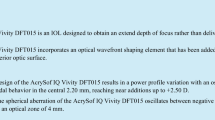Abstract
Aiming at the correction of high-order aberrations of human eye with spectacles, a design method of aspheric spectacles is proposed based on the eye’s wavefront aberrations data. Regarding the eyeball and the spectacles as a whole system-the lens-eye system-the surface profiles of the spectacles are achieved by optimization procedure of lens design. Different from the conventional optometry, in which the refraction prescription is acquired with a visual chart, the design takes into account the two aspects of actual human viewing, eyeball rolling and certain distinct viewing field. The rotation angle of eyeball is set to be ±20° as wearing spectacles, and the field of view is set to be ±7° which is especially important as watching screen display. The individual eye model is constructed as the main part of the lens-eye system. The Liou eye model is modified by sticking a thin meniscus lens to the crystalline lens. Then the defocus of the individual eye is transferred to the front surface of the meniscus lens, and the astigmatism and high-order aberrations are transferred to the front surface of the cornea. 50 eyes are involved in this research, among which 36 eyes have good enough visual performance already after sphero-cylindrical correction. 10 eyes have distinct improvement in vision and 4 eyes have no visual improvement by further aspheric correction. 6 typical subject eyes are selected for the aberrations analysis and the spectacles design in this paper. It is shown that the validity of visual correction of aspheric lens depends on the characteristics of the eye’s wavefront aberrations, and it is effective for the eye with larger astigmatism or spherical aberration. Compared with sphero-cylindrical correction only, the superiority taken by the aspheric correction is mainly on the improvement of MTF at a larger field of view. For the best aspheric correction, the MTF values increase by 18.87%, 38.34%, 44.36%, 51.29% and 57.32% at the spatial frequencies of 40, 80, 100, 125 and 150 cycles/mm, respectively.
Similar content being viewed by others
References
Jia Q, Jin Y. Spectacle Lenses. Beijing: People’s Hygiene Press, 2004. 8–18, 61, 220–221
Rubin M L. Spectacles: Past, present and future. Surv Ophthalmol, 1986, 30: 321–327
Helmholtz H. Helmholtz’s Treatise on Physiological Optics. New York: Optical Society of America, 1924
Liang J Z, Williams D R. Aberrations and retinal image quality of the normal human eye. J Opt Soc Am A, 1997, 14: 2873–2882
Bally I L. Clinical investigation into the vision performance provided by the iZon spectacle lens system. Rev Optom, 2008, 10: 1–15
Catania L. Wavefront diagnosis: The future of vision and eyecare. In: Presentation at 107th Annual Optometric Association Congress 2004. Orlando, July 22–25, 2004
Abitbol B. Aberration Correction Spectacle Lens. United States Patent. US 2002/0196412 A1, Dec. 26, 2002
Blaker J W. Toward an adaptive model of the human eye. J Opt Soc Am A, 1980, 70: 220–223
Gullstrand A. Appendicesn II and IV. Helmholtz’s Handbuch der Physiologischen Optik, 1909. 301–358, 382–415
Liou H L, Brennan N A. Anatomically accurate, finite model eye for optical modeling. J Opt Soc Am A, 1997, 14: 1684–1695
Shen W M, Xue M Q. Aberration analysis and optical design of aspheric spectacle lens. Acta Optica Sinica, 2002, 22: 743–748
Ren J F, Yu G H, Yu J C. High order aspherical spectacle lens design. Opt Tech, 2006, 32: 906–908, 911
Guo P J, Yu J C. Aspheric Spectacle Lens. P.R.C. Patent. CN 1412604A, 2002
Garner L F, Smith G. Changes in equivalent and gradient refractive index of the crystalline lens with accommodation. Optom Vis Sci, 1997, 74: 114–119
Koretz J F, Cook C A, Kaufman P L. Aging of the human lens: Changes in lens shape upon accommodation and with accommodative loss. J Opt Soc Am A, 2002, 19: 144–151
Wang W, Wang Z Q, Wang Y, et al. Wave-front aberrations of cornea and crystalline lens. Chin Phys Lett, 2006, 23: 607–609
ZEMAX Optical Design Program User’s Guide, 2005. 283
Zhang Y M. Applied Optics. Beijing: Publishing House of Electronics and Industry, 2008. 472–474
Chen R S, Chen D C, Chen B Y, et al. Systematic design of myopic ophthalmic lens. Asian J Arts Sci, 2010, 1: 83–95
Wang W, Wang Z Q, Wang Y, et al. Measurements of AIM for visible wavelength based on individual eye model. Chin Phys Lett, 2006, 23: 3263–3266
Ge J J, Wang Z Q, Wang Y, et al. Characteristics and new measurement method of NCSFs of individual color mechanisms of human vision. Chin Phys Lett, 2010, 27: 054201
Author information
Authors and Affiliations
Corresponding author
Rights and permissions
About this article
Cite this article
Li, R., Wang, Z., Liu, Y. et al. A method to design aspheric spectacles for correction of high-order aberrations of human eye. Sci. China Technol. Sci. 55, 1391–1401 (2012). https://doi.org/10.1007/s11431-012-4762-4
Received:
Accepted:
Published:
Issue Date:
DOI: https://doi.org/10.1007/s11431-012-4762-4




